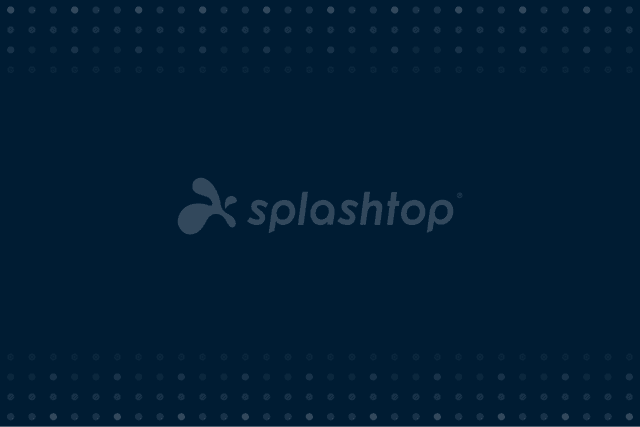As remote work and IT management continue to grow, securing remote connections has become a top priority for businesses. Network Level Authentication is a security feature that enhances remote access by requiring users to authenticate before establishing a session, reducing the risk of unauthorized access and cyber threats.
In this guide, we’ll explore what NLA is, why it’s essential, and how Splashtop Secure Workspace leverages it to enhance remote access security. Whether you’re an IT professional or simply looking to enhance remote desktop security, this article will provide the insights you need.
What Is Network Level Authentication?
Network Level Authentication (NLA) is a security feature for Remote Desktop Protocol (RDP) connections that requires users to authenticate before a remote desktop session is established. Unlike traditional authentication methods, where the login screen is displayed before verification, NLA ensures that only authenticated users can initiate a session. This prevents unauthorized users from even reaching the login prompt, reducing exposure to cyber threats such as brute-force attacks and denial-of-service (DoS) attempts.
By implementing NLA, organizations enhance their network security by limiting access to only verified users, improving both data protection and system resource efficiency.
Why Network Level Authentication Is Crucial
Implementing NLA offers several advantages for organizations looking to enhance security and efficiency in remote desktop access:
Enhanced Security Through Pre-Session Authentication
NLA ensures that authentication occurs before a remote desktop session is initiated, reducing the risk of unauthorized access. This process strengthens security by verifying users before they connect to the system.Protection Against Unauthorized Access
Without NLA, attackers can attempt brute-force login attempts or exploit system vulnerabilities to gain access. With NLA enabled, authentication is required at the network level, adding an additional security layer.Reduced System Resource Consumption
NLA minimizes the risk of resource exhaustion attacks by verifying user credentials before establishing a session, preventing unauthorized users from consuming system resources.Compatibility with Modern Authentication Methods
NLA supports modern authentication protocols, including multi-factor authentication (MFA) and smart card authentication, ensuring secure access while aligning with industry security standards.Mitigates Brute Force Attacks
Since authentication happens before a remote session starts, it prevents unauthorized users from even reaching the login screen, reducing the chances of brute-force attacks targeting user credentials.
By enabling NLA, organizations can significantly enhance remote access security while ensuring efficient resource management and protection against cyber threats.
Enhancing Security with Splashtop Secure Workspace's Network Level Authentication
Splashtop Secure Workspace (SSW) provides organizations with secure, policy-driven remote access to private applications, ensuring strict access control and data protection. As part of its robust security framework, SSW allows administrators to enforce NLA for RDP-based applications, requiring users to authenticate before initiating a remote session, ensuring compliance with organizational security policies.
Key Benefits of NLA in Splashtop Secure Workspace
Pre-Session Authentication: Users must verify their identity before establishing an RDP session, preventing unauthorized access attempts.
Policy-Based Security Controls: Administrators can enforce NLA and other security policies to align with compliance frameworks.
Granular User Access Management: IT teams can define who has access to specific private applications, restricting connections based on user roles and permissions.
Beyond NLA: Additional Security Measures in Splashtop Secure Workspace
While NLA strengthens RDP security, SSW provides a complete security framework with features that extend beyond traditional authentication methods:
Multi-Factor Authentication (MFA): Ensures strong identity verification before granting remote access.
End-to-End Encryption: Uses AES-256 encryption and TLS security protocols to protect data in transit.
Zero Trust Access Model: Restricts remote access only to verified users, reducing potential attack surfaces.
By integrating NLA with these advanced security controls, Splashtop Secure Workspace offers organizations a powerful and secure remote access solution for managing private applications and RDP environments.
Why Splashtop Secure Workspace is a Secure Alternative to Traditional RDP with NLA
While NLA is an important security feature for RDP connections, traditional RDP deployments still expose certain risks, such as open ports and credential-based attacks. With Splashtop Secure Workspace, organizations benefit from a more robust security model that integrates:
Advanced authentication mechanisms (NLA, MFA, and access policies)
Encrypted tunnels that protect remote sessions from unauthorized interception
Centralized access control to enforce security policies across multiple applications
Unlike standard RDP with NLA, Splashtop Secure Workspace eliminates the need for direct RDP exposure, reducing the risk of external attacks while ensuring seamless, secure remote access.
Try Splashtop Secure Workspace for Free
Want to secure your remote connections with authentication-first access and encrypted remote sessions? Try Splashtop Secure Workspace for free today and experience a secure, streamlined way to manage private applications and remote desktops.


